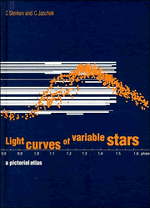Book contents
- Frontmatter
- Contents
- List of contributors
- Preface
- Acknowledgements
- Journal abbreviations
- Acronyms and abbreviations
- 1 Introduction
- 2 Eruptive variables
- 3 Pulsating variables
- 4 Rotating variables
- 5 Cataclysmic (explosive and nova-like) variables
- 6 Eclipsing binary systems
- 7 X-Ray binaries
- References
- Addresses of interest
- Appendix: Tables
- Illustration credits
- Object index
- Subject index
4 - Rotating variables
Published online by Cambridge University Press: 23 November 2009
- Frontmatter
- Contents
- List of contributors
- Preface
- Acknowledgements
- Journal abbreviations
- Acronyms and abbreviations
- 1 Introduction
- 2 Eruptive variables
- 3 Pulsating variables
- 4 Rotating variables
- 5 Cataclysmic (explosive and nova-like) variables
- 6 Eclipsing binary systems
- 7 X-Ray binaries
- References
- Addresses of interest
- Appendix: Tables
- Illustration credits
- Object index
- Subject index
Summary
Ap and roAp stars
The existence of stars whose surface is severely depleted in He with, at the same time, overabundance of Fe, Si and Cr in spots, has been known since the early days of spectral classification, when the phenomenon was first detected in Ap stars (for details, see Jaschek & Jaschek 1987, Morgan 1933).
Chemically-peculiar (CP) stars, in general, are stars of spectral type B2- F of which the spectra reveal signatures of chemical peculiarities such as, for example, strongly-enhanced spectral lines of Fe and rare-earth elements. In this group, there is a magnetic sequence - referring to, as Hensberge (1994) puts it, ‘ those stars that show a magnetic field that is strong and global (a large dipolar contribution to the field), so that it is detectable with the present [observing] techniques. It does not imply that HgMn stars, or metallic-line (Am) stars, etc. would have no magnetic field at all. Stars in the non-magnetic sequence may be either without field, with a significantly weaker global field, or with a strong field of complicated structure, such that the measurable effect, averaged-out over the visible disc, is insignificant’. Ap stars have global surface magnetic fields of the order of 0.3 to 30 kG (thousands of times stronger than that of the sun), and the effective magnetic-field strength varies with rotation, a situation that led to interpretation in terms of the oblique-rotator model in which the magnetic axis is oblique to the rotation axis (this model was first suggested by Stibbs in 1950). The time scales of light variations seen in Ap stars range from minutes to decades.
- Type
- Chapter
- Information
- Light Curves of Variable StarsA Pictorial Atlas, pp. 112 - 128Publisher: Cambridge University PressPrint publication year: 1996



